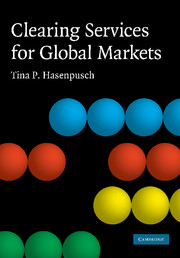 Clearing Services for Global Markets
Clearing Services for Global Markets Book contents
- Frontmatter
- Contents
- List of figures
- List of abbreviations
- Acknowledgements
- Foreword
- 1 Introduction
- 2 Setting the stage – definitions and industry setting
- 3 Defining the core issues – efficiency and network strategies
- 4 Collecting empirical insights – introduction to the empirical study
- 5 Analysing costs of derivatives clearing – transaction cost studies
- 6 Exploring theoretical basics – scale effects in clearing
- 7 What theory reveals – framework for efficiency analysis of network strategies
- 8 Checking theory against reality – case studies of network strategies
- 9 Quantifying the efficiency impact – European network strategies
- 10 Introducing the future network economy – development of the clearing industry
- 11 Summary, discussion and recommendations for future research
- Appendices
- Bibliography
- Index
7 - What theory reveals – framework for efficiency analysis of network strategies
Published online by Cambridge University Press: 19 January 2010
- Frontmatter
- Contents
- List of figures
- List of abbreviations
- Acknowledgements
- Foreword
- 1 Introduction
- 2 Setting the stage – definitions and industry setting
- 3 Defining the core issues – efficiency and network strategies
- 4 Collecting empirical insights – introduction to the empirical study
- 5 Analysing costs of derivatives clearing – transaction cost studies
- 6 Exploring theoretical basics – scale effects in clearing
- 7 What theory reveals – framework for efficiency analysis of network strategies
- 8 Checking theory against reality – case studies of network strategies
- 9 Quantifying the efficiency impact – European network strategies
- 10 Introducing the future network economy – development of the clearing industry
- 11 Summary, discussion and recommendations for future research
- Appendices
- Bibliography
- Index
Summary
Interconnection [between competing networks] upsets the normal competitive model in several ways…But interconnection also allows competitors to become a source of customers for one another when one provider originates traffic and another eventually delivers it.
The ultimate research objective of this study is to determine the efficiency impact of various network strategies within the European clearing industry. An assessment of this impact serves to identify the most preferable future clearing industry structure.
To this end, Chapter 7 establishes an original framework to explore the impact of network strategies on the efficiency of clearing. The framework builds on the findings of the previous chapters and consists of four matrices that serve to gauge the efficiency impact of the various network strategies. The matrices illustrate the complex relationships between demand- and supply-side scale effects in clearing as well as the impact of these effects on transaction costs and industry efficiency. Additionally, the matrices take other industry-impacting dynamics into account, ultimately revealing that although some scenarios are cost efficient, they are not necessarily profit-maximising for all participants of the Value Provision Network. The analysis conducted in this chapter delivers preliminary findings that are then compared with case study findings in Chapter 8; this allows final conclusions to be drawn regarding the efficiency impact of various network strategies within the European clearing industry.
- Type
- Chapter
- Information
- Clearing Services for Global MarketsA Framework for the Future Development of the Clearing Industry, pp. 239 - 284Publisher: Cambridge University PressPrint publication year: 2009


